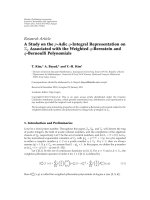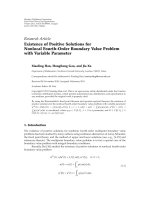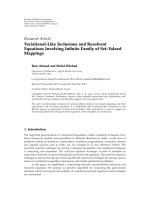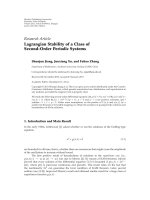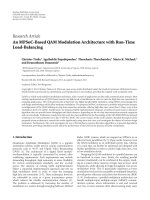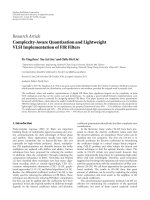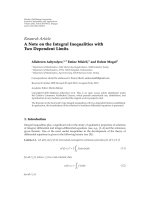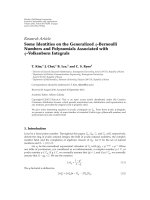Báo cáo hóa học: "Research Article Variational Method to the Impulsive Equation with Neumann Boundary Conditions" docx
Bạn đang xem bản rút gọn của tài liệu. Xem và tải ngay bản đầy đủ của tài liệu tại đây (548.41 KB, 17 trang )
Hindawi Publishing Corporation
Boundary Value Problems
Volume 2009, Article ID 316812, 17 pages
doi:10.1155/2009/316812
Research Article
Variational Method to the Impulsive Equation with
Neumann Boundary Conditions
Juntao Sun and Haibo Chen
Department of Mathematics, Central South University, Changsha, 410075 Hunan, China
Correspondence should be addressed to Juntao Sun,
Received 28 August 2009; Accepted 28 September 2009
Recommended by Pavel Dr
´
abek
We study the existence and multiplicity of classical solutions for second-order impulsive Sturm-
Liouville equation with Neumann boundary conditions. By using the variational method and
critical point theory, we give some new criteria to guarantee that the impulsive problem has at
least one solution, two solutions, and infinitely many solutions under some different conditions,
respectively. Some examples are also given in this paper to illustrate the main results.
Copyright q 2009 J. Sun and H. Chen. This is an open access article distributed under the Creative
Commons Attribution License, which permits unrestricted use, distribution, and reproduction in
any medium, provided the original work is properly cited.
1. Introduction
In this paper, we consider the boundary value problem of second-order Sturm-Liouville
equation with impulsive effects
−
p
t
u
t
r
t
u
t
q
t
u
t
g
t, u
t
,t
/
t
k
, a.e.t∈
0, 1
,
−Δ
p
t
k
u
t
k
I
k
u
t
k
,k 1, 2, ,p− 1,
u
0
u
1
−
0,
1.1
where 0 t
0
<t
1
<t
2
< ··· <t
p−1
<t
p
1,p ∈ C
1
0, 1,r,q ∈ C0, 1 with p and q
positive functions, g : 0, 1 × R → R is a continuous function, I
k
: R → R, 1 ≤ k ≤ p − 1are
continuous, −Δpt
k
u
t
k
−pt
k
u
t
k
−u
t
−
k
, u
t
k
and u
t
−
k
denote the right and the
left limits, respectively, of u
t at t t
k
, u
0
is the right limit of u
0,andu
1
−
is the left
limit of u
1.
In the recent years, a great deal of work has been done in the study of the
existence of solutions for impulsive boundary value problems IBVPs, by which a number
2 Boundary Value Problems
of chemotherapy, population dynamics, optimal control, ecology, industrial robotics, and
physics phenomena are described. For the general aspects of impulsive differential equations,
we refer the reader to the classical monograph 1. For some general and recent works on
the theory of impulsive differential equations, we refer the reader to 2–9. Some classical
tools or techniques have been used to study such problems in the literature. These classical
techniques include the coincidence degree theory of Mawhin 10, the method of upper and
lower solutions with monotone iterative technique 11, and some fixed point theorems in
cones 12–14.
On the other hand, in the last two years, some researchers have used variational
methods to study the existence of solutions for impulsive boundary value problems.
Variational method has become a new powerful tool to study impulsive differential
equations, we refer the reader to 15–20. More precisely, in 15, the authors studied the
following equation with impulsive effects:
−
ρ
t
φ
p
u
t
s
t
φ
p
u
t
f
t, u
t
,t
/
t
j
, a.e.t∈
a, b
,
−Δ
ρ
t
j
φ
p
u
t
j
I
j
u
t
j
,j 1, 2, ,l,
αu
a
− βu
a
A, γu
b
σu
b
B,
1.2
where f : a, b × 0, ∞ → 0, ∞ is continuous, I
j
: 0, ∞ → 0, ∞,j 1, 2, ,l,are
continuous, and α, β, γ, σ > 0. They essentially proved that IBVP 1.2 has at least two positive
solutions via variational method. Recently, in 16, using variational method and critical point
theory, Nieto and O’Regan studied the existence of solutions of the following equation:
−u
t
λu
t
f
t, u
t
,t
/
t
j
, a.e.t∈
0,T
,
Δ
u
t
j
I
j
u
t
j
,j 1, 2, ,l,
u
0
u
T
0,
1.3
where f : 0,T × R → R is continuous, and I
j
: R → R,j 1, 2, ,l are continuous.
They obtained that IBVP 1.3 has at least one solution. Shortly, in 17, authors extended the
results of IBVP 1.3.
In 19,Zhou and Li studied the existence of solutions of the following equation:
−u
t
g
t
u
t
f
t, u
t
,t
/
t
j
, a.e.t∈
0,T
,
Δ
u
t
j
I
j
u
t
j
,j 1, 2, ,p,
u
0
u
T
0,
1.4
where f : 0,T × R → R is continuous, and I
j
: R → R,j 1, 2, ,p, are continuous.
They proved that IBVP 1.4 has at least one solution and infinitely many solutions by using
variational method and critical point theorem.
Motivated by the above facts, in this paper, our aim is to study the variational structure
of IBVP 1.1 in an appropriate space of functions and obtain the existence and multiplicity
of solutions for IBVP 1.1 by using variational method. To the best of our knowledge, there
Boundary Value Problems 3
is no paper concerned impulsive differential equation with Neumann boundary conditions
via variational method. In addition, this paper is a generalization of 21, in which impulse
effects are not involved.
In this paper, we will need the following conditions.
H1 There is constants β>2,M >0 such that for every t ∈ 0, 1 and u ∈ R with |u|≥M,
0 <βG
t, u
≤ ug
t, u
, 0 <β
u
0
I
k
s
ds ≤ uI
k
u
,
1.5
where Gt, u
u
0
gt, sds.
H2 lim
u →0
gt, u/u 0 uniformly for t ∈ 0, 1, and lim
u →0
I
k
u/u 0.
H3 There exist numbers h
1
,h
2
> 0andp
1
> 1 such that
g
t, u
≤ h
1
h
2
|
u
|
p
1
for u ∈ R,t∈
0, 1
. 1.6
H4 There exist numbers a
k
,b
k
> 0andγ
k
∈ 0, 1 such that
I
k
u
≤ a
k
b
k
|
u
|
γ
k
for u ∈ R. 1.7
H5 There exist numbers r
1
,r
2
> 0andμ ∈ 0, 1 such that
g
t, u
≤ r
1
r
2
|
u
|
μ
for u ∈ R,t∈
0, 1
. 1.8
H6 There exist numbers a
k
,b
k
> 0andγ
k
∈ 1, ∞ such that
I
k
u
≤ a
k
b
k
|
u
|
γ
k
for u ∈ R.
1.9
This paper is organized as follows. In Section 2, we present some preliminaries. In
Section 3, we discuss the existence and multiplicity of classical solutions to IBVP 1.1. Some
examples are presented in this section to illustrate our main results in the last section.
2. Preliminaries
Take Lt
t
0
rs/psds. Then e
−Lt
∈ C
1
0, 1. We transform IBVP 1.1 into the
following equivalent form:
−
e
−L
t
p
t
u
t
e
−L
t
q
t
u
t
e
−L
t
g
t, u
t
,t
/
t
k
, a.e.t∈
0, 1
,
−Δ
e
−L
t
k
p
t
k
u
t
k
e
−L
t
k
I
k
u
t
k
,k 1, 2, ,p− 1,
u
0
u
1
−
0.
2.1
4 Boundary Value Problems
Obviously, the solutions of IBVP 2.1 are solutions of IBVP 1.1.Soitsuffices to consider
IBVP 2.1.
In this section, the following theorem will be needed in our argument. Suppose that E
is a Banach space in particular a Hilbert space and ϕ ∈ C
1
E, R. We say that ϕ satisfies the
Palais-Smale condition if any sequence {u
j
}⊂E for which ϕu
j
is bounded and ϕ
u
j
→ 0
as j → ∞ possesses a convergent subsequence in X.LetB
r
be the open ball in X with the
radius r and centered at 0 and ∂B
r
denote its boundary.
Theorem 2.1 22, Theorem 38.A. For the functional F : M ⊆ X → −∞, ∞ with
M
/
∅, min
u∈M
Fuα has a solution for which the following hold:
i X is a real reflexive Banach space;
ii M is bounded and weakly sequentially closed;
iii F is weakly sequentially lower semicontinuous on M; that is, by definition, for each
sequence {u
n
} in M such that u
n
uas n →∞, one has Fu ≤ lim inf
n →∞
Fu
n
holds.
Theorem 2.2 16, Theorem 2.2. Let E be a real Banach space and let ϕ ∈ C
1
E, R satisfy the
Palais-Smale condition. Assume there exist u
0
,u
1
∈ E and a bounded open neighborhood Ω of u
0
such
that u
1
∈ E \ Ω and
max
ϕ
u
0
,ϕ
u
1
< inf
x∈∂Ω
ϕ
u
.
2.2
Let
Γ
{
h | h :
0, 1
−→ E is continuous and h
0
u
0
,h
1
u
1
}
,
c inf
h∈Γ
max
s∈
0,1
ϕ
h
s
.
2.3
Then c is a critical value of ϕ; that is, there exists u
∗
∈ E such that ϕ
u
∗
Θand ϕu
∗
c,where
c>max{ϕu
0
,ϕu
1
}.
Theorem 2.3 23. Let E be a real Banach space, and let ϕ ∈ C
1
E, R be even satisfying the
Palais-Smale condition and ϕ00.IfE V ⊕Y ,whereV is finite dimensional, and ϕ satisfies that
A1 there exist constants ρ, α > 0 such that ϕ|
∂B
r
∩Y
≥ α,
A2 for each finite dimensional subspace W ⊂ E,thereisR RW such that ϕu ≤ 0 for all
u ∈ W with u≥R.
Then ϕ possesses an unbounded sequence of critical values.
Let us recall some basic knowledge. Denote by X the Sobolev space W
1,2
0, 1,and
consider the inner product
u, v
1
0
u
t
v
t
dt
1
0
u
t
v
t
dt
2.4
Boundary Value Problems 5
which induces the usual norm
u
1
0
u
t
2
dt
1
0
|
u
t
|
2
dt
1/2
.
2.5
We also consider the inner product
u, v
X
1
0
e
−L
t
p
t
u
t
v
t
dt
1
0
e
−L
t
q
t
u
t
v
t
dt,
2.6
and the norm
u
X
1
0
e
−L
t
p
t
u
t
2
dt
1
0
e
−L
t
q
t
|
u
t
|
2
dt
1/2
,
2.7
then the norm ·
X
is equivalent to the usual norm ·in W
1,2
0, 1. Hence, X is reflexive.
We define the norm in C0, 1,L
2
0, 1 as u
∞
max
t∈0,1
|ut| and u
2
1
0
|u|
2
dt
1/2
,
respectively.
For u ∈ W
2,2
0, 1, we have that u, u
are absolutely continuous, and u
∈ L
2
0, 1,
hence −Δe
−L
t
k
pt
k
u
t
k
−e
−L
t
k
pt
k
u
t
k
− u
t
−
k
0, for any t
k
∈ 0, 1.Ifu ∈
X, then u is absolutely continuous and u
∈ L
2
0, 1. In this case, the one-side derivatives
u
0
,u
1
−
,u
t
k
,u
t
−
k
,k 1, 2, ,p − 1 may not exist. As a consequence, we need to
introduce a different concept of solution. We say that u ∈ C0, 1 is a classical solution of
IBVP 2.1 if it satisfies the equation in IBVP 2.1 a.e. on 0, 1, the limits u
t
k
,u
t
−
k
,k
1, 2, ,p−1 exist and impulsive conditions in IBVP 2.1 hold, u
0
,u
1
−
exist and u
0
u
1
−
0. Moreover, for every k 0, 1, ,p− 1,u
k
u|
t
k
,t
k1
satisfy u
k
∈ W
2,2
t
k
,t
k1
.
For each u ∈ X, consider the functional ϕ defined on X by
ϕ
u
1
2
u
2
X
−
p−1
k1
e
−Lt
k
ut
k
0
I
k
s
ds −
1
0
e
−L
t
G
t, u
dt.
2.8
It is clear that ϕ is differentiable at any u ∈ X and
ϕ
u
v
1
0
e
−L
t
p
t
u
t
v
t
e
−L
t
q
t
u
t
v
t
dt
−
p−1
k1
e
−L
t
k
I
k
u
t
k
v
t
k
−
1
0
e
−L
t
g
t, u
t
v
t
dt
2.9
for any v ∈ X. Obviously, ϕ
is continuous.
Lemma 2.4. If u ∈ X is a critical point of the functional ϕ,thenu is a classical solution of IBVP
2.1.
6 Boundary Value Problems
Proof. Let u ∈ X be a critical point of the functional ϕ. It shows that
1
0
e
−L
t
p
t
u
t
v
t
e
−L
t
q
t
u
t
v
t
dt
−
p−1
k1
e
−L
t
k
I
k
u
t
k
v
t
k
−
1
0
e
−L
t
g
t, u
t
v
t
dt0
2.10
holds for any v ∈ X. Choose any j ∈{0, 1, 2, ,p − 1} and v ∈ X such that vt0if
t ∈ t
k
,t
k1
for k
/
j. Equation 2.10 implies
t
j1
t
j
e
−L
t
p
t
u
t
v
t
e
−L
t
q
t
u
t
v
t
− e
−L
t
g
t, u
t
v
t
dt 0.
2.11
This means, for any w ∈ W
1,2
0
t
j
,t
j1
,
t
j1
t
j
e
−L
t
p
t
u
j
t
w
t
e
−L
t
q
t
u
j
t
w
t
− e
−L
t
g
t, u
j
t
w
t
dt 0,
2.12
where u
j
u|
t
j
,t
j1
.Thusu
j
is a weak solution of the following equation:
−
e
−L
t
p
t
u
t
e
−L
t
q
t
u
t
e
−L
t
g
t, u
t
t ∈
t
j
,t
j1
,
2.13
and therefore u
j
∈ W
1,2
0
t
j
,t
j1
⊂ Ct
j
,t
j1
. Let ht : e
−L
t
gt, u − qu, then 2.13
becomes the following form:
−
e
−L
t
p
t
u
t
h
t
on
t
j
,t
j1
,j 0, 1, 2, ,p−1.
2.14
Then the solution of 2.14 can be written as
u
j
t
C
1
C
2
t
t
j
e
Ls−ln ps
ds −
t
t
j
e
Ls−ln ps
s
t
j
h
r
p
r
e
ln pr
dr
ds t ∈
t
j
,t
j1
, 2.15
where C
1
and C
2
are two constants. T hen u
j
∈ Ct
j
,t
j1
and u
j
∈ Ct
j
,t
j1
. Therefore, u
j
is a classical solution of 2.13 and u satisfies the equation in IBVP 2.1 a.e. on 0, 1.Bythe
Boundary Value Problems 7
previous equation, we can easily get that the limits u
t
j
,u
t
−
j
,j 1, 2, ,p−1,u
t
0
and
u
t
−
p
exist. By integrating 2.10, one has
1
0
e
−L
t
p
t
u
t
v
t
e
−L
t
q
t
u
t
v
t
dt
−
p−1
k1
e
−L
t
k
I
k
u
t
k
v
t
k
−
1
0
e
−L
t
g
t, u
t
v
t
dt
−
p−1
k1
Δ
e
−L
t
k
p
t
k
u
t
k
v
t
k
e
−L
1
p
1
u
1
−
v
1
− e
−L0
p
0
u
0
v
0
−
p−1
k1
e
−Lt
k
I
k
u
t
k
v
t
k
1
0
−
e
−L
t
p
t
u
t
e
−L
t
q
t
u
t
− e
−L
t
g
t, u
t
v
t
dt
−
p−1
k1
Δ
e
−L
t
k
p
t
k
u
t
k
e
−L
t
k
I
k
u
t
k
v
t
k
e
−L
1
p
1
u
1
−
v
1
− e
−L
0
p
0
u
0
v
0
1
0
−
e
−L
t
p
t
u
t
e
−L
t
q
t
u
t
− e
−L
t
g
t, u
t
v
t
dt 0,
2.16
and combining with 2.13 we get
−
p−1
k1
Δ
e
−L
t
k
p
t
k
u
t
k
e
−L
t
k
I
k
u
t
k
v
t
k
e
−L
1
p
1
u
1
−
v
1
− e
−L
0
p
0
u
0
v
0
0.
2.17
Next we will show that u satisfies the impulsive conditions in IBVP 2.1. If not, without loss
of generality, we assume that there exists i ∈{1, 2, ,p− 1} such that
e
−L
t
i
I
i
u
t
i
Δ
e
−L
t
i
p
t
i
u
t
i
/
0. 2.18
Let
v
t
p
k0,k
/
i
t − t
k
.
2.19
8 Boundary Value Problems
Obviously, v ∈ X. Substituting them into 2.17,weget
Δe
−L
t
i
p
t
i
u
t
i
e
−L
t
i
I
i
u
t
i
v
t
i
0 2.20
which contradicts 2.18.Sou satisfies the impulsive conditions in IBVP 2.1.Thus,2.17
becomes the following form:
e
−L
1
p
1
u
1
−
v
1
− e
−L
0
p
0
u
0
v
0
0,
2.21
for all v ∈ X. Since v0,v1 are arbitrary, 2.21 shows that e
−L
1
p1u
1
−
e
−L
0
p0u
0
0, and it implies u
1
−
u
0
0. Therefore, u is a classical solution
of IBVP 2.1.
Lemma 2.5. Let u ∈ X.Thenu
∞
≤ M
1
u
X
,where
M
1
2
1/2
max
1
min
t∈
0,1
e
−L
t
p
t
1/2
,
1
min
t∈
0,1
e
−L
t
q
t
1/2
.
2.22
Proof. By using the same methods of 15, Lemma 2.6, we easily obtain the above result, and
we omit it here.
3. Main Results
In this section, we will show our main results and prove them.
Theorem 3.1. Assume that (H1) and (H2) hold. Moreover, gt, u and the impulsive functions I
k
u
are odd about u,thenIBVP1.1 has infinitely many classical solutions.
Proof. Obviously, ϕ is an even functional and ϕ00. We divide our proof into three parts
in order to show Theorem 3.1.
Firstly, We will show that ϕ satisfies the Palais-Smale condition. Let {ϕu
n
} be a
bounded sequence such that lim
n →∞
ϕ
u
n
0. Then there exists constants C
3
> 0 such
that
ϕ
u
n
≤ C
3
,
ϕ
u
n
X
≤ C
3
. 3.1
Boundary Value Problems 9
By 2.8, 2.9, 3.1,andH1, we have
β
2
− 1
u
n
2
X
β
2
u
n
2
X
−
u
n
2
X
βϕ
u
n
− ϕ
u
n
u
n
β
p−1
k1
e
−Lt
k
u
n
t
k
0
I
k
s
ds β
1
0
e
−L
t
G
t, u
n
dt
−
p−1
k1
e
−L
t
k
I
k
u
n
t
k
u
n
t
k
−
1
0
e
−L
t
g
t, u
n
u
n
dt
p−1
k1
e
−Lt
k
β
u
n
t
k
0
I
k
s
ds − I
k
u
n
t
k
u
n
t
k
1
0
e
−Lt
βG
t, u
n
− g
t, u
n
u
n
dt βϕ
u
n
− ϕ
u
n
u
n
≤ βC
3
M
2
1
C
3
u
n
X
1
0
e
−Lt
dt max
t∈0,1,u
n
t∈−M,M
βG
t, u
n
− g
t, u
n
u
n
p−1
k1
e
−Lt
k
max
u
n
t
k
∈−M,M
β
u
n
t
k
0
I
k
s
ds − I
k
u
n
t
k
u
n
t
k
.
3.2
It follows that {u
n
} is bounded in X. From the reflexivity of X, we may extract a weakly
convergent subsequence that, for simplicity, we call {u
n
},u
n
uin X. In the following we
will verify that {u
n
} strongly converges to u in X.By2.9 we have
ϕ
u
n
− ϕ
u
u
n
− u
u
n
− u
2
X
−
p−1
k1
e
−L
t
k
I
k
u
n
t
k
− I
k
u
t
n
u
n
t
k
− u
t
k
−
1
0
e
−L
t
g
t, u
n
t
− g
t, u
t
u
n
t
− u
t
dt.
3.3
By u
n
uin X,weseethat{u
n
} uniformly converges to u in C0, 1.So
1
0
e
−L
t
g
t, u
n
t
− g
t, u
t
u
n
t
− u
t
dt −→ 0,
p−1
k1
e
−L
t
k
I
k
u
n
t
k
− I
k
u
t
k
u
n
t
k
− u
t
k
−→ 0,
ϕ
u
n
− ϕ
u
u
n
− u
−→ 0asn −→ ∞.
3.4
10 Boundary Value Problems
By 3.3, 3.4,weobtainu
n
− u
X
→ 0asn → ∞.Thatis,{u
n
} strongly converges to u in
X, which means the that P. S. condition holds for ϕ.
Secondly, we verify the condition A1 in Theorem 2.3.LetV R,Y {u ∈ X |
1
0
utdt 0}, then X V ⊕ Y, where dim V 1 < ∞.InviewofH2, take ε
min{1/8M
2
1
1
0
e
−L
t
dt, 1/8M
2
1
p−1
k1
e
−L
t
k
} > 0, there exists an δ>0 such that for every u
with |u| <δ,
G
t, u
≤ ε
|
u
|
2
,
u
0
I
k
s
ds ≤ ε
|
u
|
2
.
3.5
Hence, for any u ∈ Y with u
X
≤ δ/M
1
,by2.8 and 3.5 , we have
ϕ
u
1
2
u
2
X
−
p−1
k1
e
−Lt
k
ut
k
0
I
k
s
ds −
1
0
e
−L
t
G
t, u
dt
≥
1
2
u
2
X
−
p−1
k1
e
−Lt
k
ε
|
u
k
t
k
|
2
−
1
0
e
−Lt
ε
|
u
t
|
2
dt
≥
1
2
u
2
X
− εM
2
1
p−1
k1
e
−Lt
k
u
2
X
− εM
2
1
1
0
e
−Lt
dt
u
2
X
≥
1
2
u
2
X
−
1
8
u
2
X
−
1
8
u
2
X
1
4
u
2
X
.
3.6
Take α δ
2
/4M
2
1
,ρ δ/M
1
, then ϕu ≥ α, ∀u ∈ Y ∩ ∂B
ρ
.
Finally, we verify condition A2 in Theorem 2.3. According to H1, f or any u ≥ M>0
and t ∈ 0, 1 we have that
G
t, u
u
β
u
u
β
g
t, u
− βu
β−1
G
t, u
u
2β
ug
t, u
− βG
t, u
u
β1
≥ 0.
3.7
Hence
G
t, u
u
β
≥
G
t, M
M
β
≥ M
−β
min
t∈
0,1
G
t, M
C
> 0
3.8
for all t ∈ 0, 1 and u ≥ M>0. This implies that Gt, u ≥ C
u
β
for all t ∈ 0, 1 and u ≥ M>0.
Similarly, we can prove that there is a constant C
> 0 such that Gt, u ≥ C
|u|
β
for all t ∈ 0, 1
and u ≤−M. Since Gt, u −C
4
|u|
β
is continuous on 0, 1 ×−M, M, there exists C
5
> 0 such
Boundary Value Problems 11
that Gt, u − C
4
|u|
β
> −C
5
on 0,T × −M, M. Thus, we have
G
t, u
≥ C
4
|
u
|
β
− C
5
∀
t, u
∈
0, 1
× R,
3.9
where C
4
min{C
,C
}.
Similarly, there exist constants C
6
,C
7
> 0 such that
u
0
I
k
s
ds ≥ C
6
|
u
|
β
− C
7
∀
t, u
∈
0, 1
× R.
3.10
For every ξ ∈ R \{0} and u ∈ W \{0},by2.8, 3.9,and3.10, we have that the
following inequality:
ϕ
ξu
≤
1
2
ξu
2
X
−
p−1
k1
e
−L
t
k
C
6
|
ξu
t
k
|
β
− C
7
−
1
0
e
−L
t
C
4
|
ξu
|
β
− C
5
dt
≤
ξ
2
2
u
2
X
−C
6
|
ξ
|
β
p−1
k1
e
−Lt
k
|
u
t
k
|
β
C
7
p−1
k1
e
−Lt
k
−C
4
|
ξ
|
β
1
0
e
−Lt
|
u
t
|
β
dtC
5
1
0
e
−Lt
dt
3.11
holds. Take w ∈ W such that w
X
1, since β>2, 3.11 implies that there exists ξ
> 0 such
that ξw
X
>ρand ϕξw < 0forξ ≥ ξ
> 0. Since W is a finite dimensional subspace, there
exists RW > 0 such that ϕu ≤ 0onW \ B
RW
.ByTheorem 2.3, ϕ possesses infinite many
critical points; that is, IBVP 1.1 has infinite many classical solutions.
Theorem 3.2. Assume that (H1) and the first equality in (H2) hold. Moreover, gt, u is odd about
u and the impulsive functions I
k
u are odd and nonincreasing. Then IBVP 1.1 has infinitely many
classical solutions.
Proof. We only verify A1 in Theorem 2.3. Since I
k
u are odd and nonincreasing continuous
functions, then for any u ∈ R,
u
0
I
k
sds < 0. So we have
p−1
k1
e
−L
t
k
u
n
t
k
0
I
k
sds < 0. Take
ε 1/8M
2
1
1
0
e
−L
t
dt > 0,α 3δ
2
/8M
2
1
,ρ δ/M
1
, like in 3.6 we can obtain the result.
Theorem 3.3. Suppose that the first inequalities in (H1), (H3), and (H4) hold. Furthermore, one
assumes that gt, u and the impulsive functions I
k
u are odd about u and we have the following.
H7 There exists A
0
> 0 such that
A
0
2
>M
1
p−1
k1
e
−L
t
k
b
k
M
γ
k
1
A
γ
k
0
a
k
M
1
h
2
M
p
1
1
A
p
1
0
h
1
1
0
e
−Lt
dt.
3.12
Then IBVP 1.1 has infinitely many classical solutions.
12 Boundary Value Problems
Proof. Obviously, ϕ is an even functional and ϕ00. Firstly, we will show that ϕ satisfies
the Palais-Smale condition. As in the proof of Theorem 3.1,by2.8, 2.9, 3.1,thefirst
inequalities in H1 and H4, we have
β
2
− 1
u
n
2
X
β
2
u
n
2
X
−
u
n
2
X
βϕ
u
n
− ϕ
u
n
u
n
β
p−1
k1
e
−Lt
k
u
n
t
k
0
I
k
s
ds β
1
0
e
−L
t
G
t, u
n
dt
−
p−1
k1
e
−L
t
k
I
k
u
n
t
k
u
n
t
k
−
1
0
e
−L
t
g
t, u
n
u
n
dt
βϕ
u
n
− ϕ
u
n
u
n
1
0
e
−Lt
βG
t, u
n
− g
t, u
n
u
n
dt
β
p−1
k1
e
−Lt
k
u
n
t
k
0
I
k
s
ds −
p−1
k1
e
−L
t
k
I
k
u
n
t
k
u
n
t
k
≤ βC
3
M
2
1
C
3
u
n
X
1
0
e
−Lt
dt max
t∈0,1,u
n
t∈−M,M
βG
t, u
n
− g
t, u
n
u
n
β 1
p−1
k1
e
−L
t
k
a
k
M
1
u
n
X
b
k
M
γ
k
1
1
u
n
γ
k
1
X
.
3.13
It follows that {u
n
} is bounded in X. In the following, the proof of P. S. condition is the same
as that in Theorem 3.1, and we omit it here.
Secondly, as in Theorem 3.1, we can obtain that condition A2 in Theorem 2.1 is
satisfied.
Take the same direct sum decomposition X V ⊕Y as in Theorem 3.1. For any u ∈ Y ,
by 2.8, H3,andH4,weobtain
ϕ
u
1
2
u
2
X
−
p−1
k1
e
−Lt
k
ut
k
0
I
k
s
ds −
1
0
e
−L
t
G
t, u
dt
≥
1
2
u
2
X
−
p−1
k1
e
−L
t
k
a
k
M
1
u
X
b
k
M
γ
k
1
1
u
γ
k
1
X
−
1
0
e
−L
t
dt
h
1
M
1
u
X
h
2
M
p
1
1
1
u
p
1
1
X
1
2
u
2
X
−
p−1
k1
e
−Lt
k
b
k
M
γ
k
1
1
u
γ
k
1
X
− h
2
M
p
1
1
1
1
0
e
−Lt
dt
u
p
1
1
X
− M
1
u
X
p−1
k1
e
−L
t
k
a
k
h
1
1
0
e
−L
t
dt
.
3.14
Boundary Value Problems 13
In view of H7,setu
X
ρ : A
0
> 0, then we have
ϕ
u
≥ α
1
2
A
2
0
−
p−1
k1
e
−Lt
k
b
k
M
γ
k
1
1
A
γ
k
1
0
− h
2
M
p
1
1
1
1
0
e
−Lt
dtA
p
1
1
0
− M
1
A
0
p−1
k1
e
−L
t
k
a
k
h
1
1
0
e
−L
t
dt
> 0.
3.15
Therefore, ϕu ≥ α, ∀u ∈ Y ∩ ∂B
ρ
. By Theorem 2.3, ϕ possesses infinite many critical points,
that is, IBVP 1.1 has infinite many classical solutions.
Theorem 3.4. Assume that the second inequalities in (H1), (H5), and (H6) hold, moreover, one
assumes the following.
H8 There exists A
1
> 0 such that
A
1
2
>M
1
p−1
k1
e
−L
t
k
b
k
M
γ
k
1
A
γ
k
1
a
k
M
1
r
2
M
μ
1
A
μ
1
r
1
1
0
e
−Lt
dt.
3.16
Then IBVP 1.1 has at least two classical solutions.
Proof. We will use Theorems 2.1 and 2.2 to prove the main results. Firstly, we will show that
ϕ satisfies the Palais-Smale condition. Similarly, as in the proof of Theorem 3.1,by2.8, 2.9,
3.1, the second inequalities in H1 and H5, we have
β
2
− 1
u
n
2
X
β
2
u
n
2
X
−
u
n
2
X
βϕ
u
n
− ϕ
u
n
u
n
β
p−1
k1
e
−Lt
k
u
n
t
k
0
I
k
s
ds β
1
0
e
−L
t
G
t, u
n
dt
−
p−1
k1
e
−L
t
k
I
k
u
n
t
k
u
n
t
k
−
1
0
e
−L
t
g
t, u
n
u
n
dt
≤ βC
3
M
2
1
C
3
u
n
X
1
0
e
−L
t
dt
r
1
r
2
M
μ
1
u
n
μ
X
β
1
0
e
−L
t
dt
M
1
r
1
u
n
X
r
2
M
μ1
1
u
n
μ1
X
p−1
k1
e
−Lt
k
max
u
n
t
k
∈−M,M
β
u
n
t
k
0
I
k
s
ds − I
k
u
n
t
k
u
n
t
k
14 Boundary Value Problems
βC
3
M
2
1
C
3
u
n
X
1
0
e
−L
t
dt
r
1
r
2
M
μ
1
u
n
μ
X
βM
1
u
n
X
1
p−1
k1
e
−Lt
k
max
u
n
t
k
∈−M,M
β
u
n
t
k
0
I
k
s
ds − I
k
u
n
t
k
u
n
t
k
.
3.17
It follows that {u
n
} is bounded in X. In the following, the proof of P. S. condition is the same
as that in Theorem 3.1, and we omit it here.
Let A>0, which will be determined later. Set B
A
: {u ∈ X : u
X
<A}, then
B
A
: {u ∈ X : u
X
≤ A} is a closed ball. From the reflexivity of X, we can easily obtain
that
B
A
is bounded and weakly sequentially closed. We will show that ϕ is weakly lower
semicontinuous on
B
A
.Let
ϕ
1
u
1
2
1
0
e
−L
t
p
t
u
t
2
dt
1
0
e
−L
t
q
t
|
u
t
|
2
dt,
ϕ
2
u
−
p−1
k1
e
−Lt
k
ut
k
0
I
k
s
ds −
1
0
e
−L
t
G
t, u
dt.
3.18
Then ϕuϕ
1
uϕ
2
u.Byu
n
uon X we see that {u
n
} uniformly converges to u
in C0, 1.Soϕ
2
is weakly continuous. Clearly, ϕ
1
is continuous, which, together with the
convexity of ϕ
1
, implies that ϕ
1
is weakly lower semicontinuous. Therefore, ϕ is weakly lower
semi-continuous on
B
A
.SobyTheorem 2.1, without loss of generality, we assume that ϕu
0
inf
u∈B
A
ϕu. Now we will show that
ϕ
u
0
< inf
u∈∂B
A
ϕ
u
.
3.19
For any u ∈ ∂B
A
,byH5 and H6, we have
ϕ
u
1
2
u
2
X
−
p−1
k1
e
−Lt
k
ut
k
0
I
k
s
ds −
1
0
e
−L
t
G
t, u
dt
≥
1
2
u
2
X
− M
1
p−1
k1
e
−L
t
k
b
k
M
γ
k
1
u
γ
k
1
X
a
k
u
X
− M
1
1
0
e
−L
t
dt
r
2
M
μ
1
u
μ1
X
r
1
u
X
.
3.20
Boundary Value Problems 15
Hence
inf
u∈∂B
A
ϕ
u
≥
1
2
u
2
X
− M
1
p−1
k1
e
−L
t
k
b
k
M
γ
k
1
u
γ
k
1
X
a
k
u
X
− M
1
1
0
e
−L
t
dt
r
2
M
μ
1
u
μ1
X
r
1
u
X
.
3.21
In view of H8, take A A
1
> 0, we have inf
u∈∂B
A
1
ϕu > 0, for any u ∈ ∂B
A
1
.Soϕu
0
<
ϕ00 < inf
u∈∂B
A
1
ϕu.
Next we will verify that there exists a u
1
with u
1
X
>A
1
such that ϕu
1
<
inf
u∈∂B
A
1
ϕu.Letξ ∈ R \{0},Bt1. Then by 3.10 and H5, we have
ϕ
ξB
ξ
2
2
1
0
e
−L
t
q
t
dt −
p−1
k1
e
−Lt
k
ξ
0
I
k
s
ds −
1
0
e
−L
t
G
t, ξ
dt
≤
ξ
2
2
1
0
e
−L
t
q
t
dt − C
6
|
ξ
|
β
p−1
k1
e
−Lt
k
C
7
p−1
k1
e
−Lt
k
r
2
|
ξ
|
μ1
r
1
|
ξ
|
1
0
e
−Lt
dt.
3.22
Since β>2, 0 ≤ μ<1, we have lim
|ξ|→∞
ϕξB−∞. Therefore, there exists a sufficiently
large ξ
0
> 0withξ
0
B
X
>A
1
such that ϕξ
0
B < inf
u∈∂B
A
1
ϕu.Setu
1
ξ
0
B, then ϕu
1
<
inf
u∈∂B
A
1
ϕu.SobyTheorem 2.2, there exists u
2
∈ X such that ϕ
u
2
0. Therefore, u
0
and
u
2
are two critical points of ϕ, and they are classical solutions of IBVP 1.1.
Remark 3.5. Obviously, if g is a bounded function, in view of Theorem 3.4, we can obtain the
same result.
Theorem 3.6. Suppose that (H4) and (H5) hold. Then IBVP 1.1 has at least one solution.
Proof. The proof is similar to that in 19, and we omit it here.
Corollary 3.7. Suppose that g and impulsive functions I
k
,k 1, 2, ,p−1 are bounded, then IBVP
1.1 has at least one solution.
4. Some Examples
Example 4.1. Consider the following problem:
−u
t
u
t
u
t
g
t, u
t
,t
/
t
k
, a.e.t∈
0, 1
,
−Δ
u
t
k
I
k
u
t
k
,k 1, 2,
u
0
u
1
−
0,
4.1
where gt, u4u
3
6tu
5
,I
k
uu
3
.
16 Boundary Value Problems
Obviously, gt, u,I
k
u are odd on u. Compared to IBVP 1.1, pt1,qt1,rt
1,k 2. By simple calculations, we obtain that M
1
√
2e.Letβ 3,M 1. Clearly, H1,
H2 are satisfied. Applying Theorem 3.1,IBVP4.1 has i nfinitely many classical solutions.
Example 4.2. Consider the following problem:
−u
t
u
t
g
t, u
t
,t
/
t
k
, a.e.t∈
0, 1
,
−Δ
u
t
k
I
k
u
t
k
,k 1,
u
0
u
1
−
0,
4.2
where gt, u1/8u
3
1/20t sin u, I
k
u1/16u
1/3
cos u.
Obviously, gt, u,I
k
u are odd on u. Compared to IBVP 1.1, pt1,qt1,rt
0,k 1. By simple calculations, we obtain that M
1
√
2,e
−Lt
1. Let β 3,M 4,m
1/20,n 1/8,a
k
0,b
k
1/16,γ
k
1/3,p
1
3. Clearly, the first inequalities in H1, H3,
and H4 are satisfied. Take A
0
1/2, then H7 is also satisfied. Applying Theorem 3.3,IBVP
4.2 has infinitely many classical solutions.
Example 4.3. Consider the following problem:
−u
t
u
t
g
t, u
t
,t
/
t
k
, a.e.t∈
0, 1
,
−Δ
u
t
k
I
k
u
t
k
,k 1,
u
0
u
1
−
0,
4.3
where gt, u1/16u
1/3
sin t, I
k
u1/2u
5
cos u.
Compared to IBVP 1.1, pt1,qt1,rt0,k 1. By simple calculations,
we obtain that M
1
√
2,e
−Lt
1. Let β 3,M 2,r
1
0,r
2
1/16,μ 1/3,a
k
1,b
k
1/2,γ
k
5. Clearly, the second inequalities in H1, H5,andH6 are satisfied.
Take A
1
1/2, then H8 is also satisfied. Applying Theorem 3.4,IBVP4.3 has at least two
classical solutions.
Acknowledgment
This project was supported by the National Natural Science Foundation of China 10871206.
References
1 V. Lakshmikantham, D. D. Ba
˘
ınov,andP.S.Simeonov,Theory of Impulsive Differential Equations, vol. 6
of Series in Modern Applied Mathematics, World Scientific, Teaneck, NJ, USA, 1989.
2 R. P. Agarwal, D. Franco, and D. O’Regan, “Singular boundary value problems for first and second
order impulsive differential equations,” Aequationes Mathematicae, vol. 69, no. 1-2, pp. 83–96, 2005.
3 B. Ahmad and J. J. Nieto, “Existence and approximation of solutions for a class of nonlinear impulsive
functional differential equations with anti-periodic boundary conditions,” Nonlinear Analysis: Theory,
Methods & Applications, vol. 69, no. 10, pp. 3291–3298, 2008.
4 J. Li, J. J. Nieto, and J. Shen, “Impulsive periodic boundary value problems of first-order differential
equations,” Journal of Mathematical Analysis and Applications, vol. 325, no. 1, pp. 226–236, 2007.
Boundary Value Problems 17
5 J. J. Nieto and R. Rodr
´
ıguez-L
´
opez, “New comparison results for impulsive integro-differential
equations and applications,” Journal of Mathematical Analysis and Applications, vol. 328, no. 2, pp. 1343–
1368, 2007.
6 A. M. Samo
˘
ılenko and N. A. Perestyuk, Impulsive Differential Equations, vol. 14 of World Scientific Series
on Nonlinear Science. Series A: Monographs and Treatises, World Scientific, River Edge, NJ, USA, 1995.
7 E. Hern
´
andez, H. R. Henr
´
ıquez, and M. A. McKibben, “Existence results for abstract impulsive
second-order neutral functional differential equations,” Nonlinear Analysis: Theory, Methods &
Applications, vol. 70, no. 7, pp. 2736–2751, 2009.
8 H. Zhang, L. Chen, and J. J. Nieto, “A delayed epidemic model with stage-structure and pulses for
pest management strategy,” Nonlinear Analysis: Real World Applications, vol. 9, no. 4, pp. 1714–1726,
2008.
9 M. Benchohra, J. Henderson, and S. Ntouyas, Impulsive Differential Equations and Inclusions, vol. 2 of
Contemporary Mathematics and Its Applications, Hindawi, New York, NY, USA, 2006.
10 D. Qian and X. Li, “Periodic solutions for ordinary differential equations with sublinear impulsive
effects,” Journal of Mathematical Analysis and Applications, vol. 303, no. 1, pp. 288–303, 2005.
11 L. Chen and J. Sun, “Nonlinear boundary value problem of first order impulsive functional
differential equations,” Journal of Mathematical Analysis and Applications, vol. 318, no. 2, pp. 726–741,
2006.
12 J. Chen, C. C. Tisdell, and R. Yuan, “On the solvability of periodic boundary value problems with
impulse,” Journal of Mathematical Analysis and Applications, vol. 331, no. 2, pp. 902–912, 2007.
13 J. Chu and J. J. Nieto, “Impulsive periodic solutions of first-order singular differential equations,”
Bulletin of the London Mathematical Society, vol. 40, no. 1, pp. 143–150, 2008.
14
J. Li and J. J. Nieto, “Existence of positive solutions for multipoint boundary value problem on the
half-line with impulses,” Boundary Value Problems, vol. 2009, Article ID 834158, 12 pages, 2009.
15 Y. Tian and W. Ge, “Applications of variational methods to boundary-value problem for impulsive
differential equations,” Proceedings of the Edinburgh Mathematical Society, vol. 51, no. 2, pp. 509–527,
2008.
16 J. J. Nieto and D. O’Regan, “Variational approach to impulsive differential equations,” Nonlinear
Analysis: Real World Applications, vol. 10, no. 2, pp. 680–690, 2009.
17 Z. Zhang and R. Yuan, “An application of variational methods to Dirichlet boundary value problem
with impulses,” Nonlinear Analysis: Real World Applications. In press.
18 Y. Tian, W. Ge, and D. Yang, “Existence results for second-order system with impulse effects via
variational methods,” Journal of Applied Mathematics and Computing, vol. 31, no. 1-2, pp. 255–265, 2009.
19 J. Zhou and Y. Li, “Existence and multiplicity of solutions for some Dirichlet problems with impulsive
effects,” Nonlinear Analysis: Theory, Methods & Applications, vol. 71, no. 7-8, pp. 2856–2865, 2009.
20 H. Zhang and Z. Li, “Variational approach to impulsive differential equations with periodic boundary
conditions,” Nonlinear Analysis: Real World Applications. In press.
21 G. Bonanno and G. D’Agu
`
ı, “A Neumann boundary value problem for the Sturm-Liouville equation,”
Applied Mathematics and Computation, vol. 208, no. 2, pp. 318–327, 2009.
22 E. Zeidler, Nonlinear Functional Analysis and Its Applications. III, Springer, New York, NY, USA, 1985.
23 P. H. Rabinowitz, Minimax Methods in Critical Point Theory with Applications to Differential Equations,
vol. 65 of CBMS Regional Conference Series in Mathematics, American Mathematical Society,
Washington, DC, USA, 1986.
24 Y. Tian and W. Ge, “Variational methods to Sturm-Liouville boundary value problem for impulsive
differential equations,” Nonlinear Analysis: Theory, Methods & Applications. In press.

